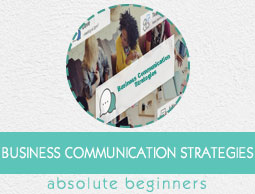
- Home
- Introduction
- Types of Communication
- Types of Communication Strategies
- Achieving Effective Communication
- Three Stages of Communication
- Listening Skills
- Knowing Your Audience
- How to Deliver Compelling Message
- Cultivating a Distinct Style of Speech
- Effective Communication Methods
- Benefits of Positive Communication
Business Communication Strategies - Quick Guide
Business Communication Strategies - Introduction
Communication in the business world is not confined to the interactions between professionals or their official communication with clients and customers. Its scope can be quite vast encompassing communications of all forms that takes place in any office environment.
This tutorial is designed to provide you with certain strategies, tools and examples to assist you in elevating your job profile and general significance in your organization by instructing you on how to use your communication skills effectively.
Significance of Communication Strategies
Cultivating good communication skills ensures that people pay close attention when you speak. It makes people comfortable with the fact that someone is listening to them when they are speaking. A meaningful conversation can help you influence others with your ideas and can help you prevent any unnecessary confusion when you communicate.
Good communication skills help you speak assertively on your goals and achievements. Without a clear communication strategy, people will stop listening to your needs and requirements.

A good speaker will always provide the listener with practical examples and case studies. He goes as far as possible to cover all the fields on effective communication as is needed for the reader, without having to opt for professional services.
Before going through with this tutorial, the reader should identify the specific areas on which he should focus on in his communication. He should also be interested in developing a detailed understanding of the working mechanisms behind the skills of communicating with others.
Outcome of Communication Strategies
Taking control of the communication channel helps in preventing any wrong signals that can be sent through a wrong choice of words, which might create a misunderstanding. To make clear communication, you need to always modify your speech as per the nature of the conversation and the purpose of the meeting.
Good communication to the staff members ensures that all instructions are clearly communicated and all staff members are operating on the same plane. In the services sector, this forms a crucial cause.
Effective communication results in the following −
Helps people develop mutually beneficial solutions for long-term partnerships.
Builds healthy relationships with people based on transparency and trust.
Providing efficient solutions through accurate, valuable and relevant information.
Delivering a positive message and understanding of facts which boosts mutual respect and trust.
Good communication is not a very difficult thing to achieve. It is having a clear vision and line of thought, along with the right attitude and the sense of timing. Unlike public perception, a good conversationalist doesnt need to be very strong in vocabulary.
In fact, the best communicators often are people with limited vocabulary, however they have managed to convert that into their own personal strength as they can now focus on the exact words they need to speak out, instead of sending vague messages through their speech.
Types of Communication
There are many ways of communication, however they can be broadly classified under three types −
- Oral Communication
- Written Communication
- Implied Messages
These can be further divided into planned, official or unplanned, unofficial conversation.
Oral Communication
In oral communication, it is important to make sure that the listeners understand what the speaker is saying. So, the speaker needs to have effective speaking and listening skills of the communicator. Oral communication is the most effective two-way communication and dialogue method. It helps send the message completely and is best suited to handle complex discussions and provides ample scope for clarifying your issues.
A few examples of oral communication are −
- Meetings
- Workshops
- Telephone calls
- Presentations
- Tele/video conferences
- Podcast/webcast, etc.
Written Communication
Writing is more suited to detailed communication, where facts, figures, diagrams and statistics should be shared. It is also beneficial as reference materials for later usage. Written communication is often mentioned as official communication because people always want important conversations to be placed on record.
Some examples of written communication are −
- Letters
- Reports
- Minutes
- Emails
- Newsletters
- Surveys
- Blogs, etc.
Implied Messages
In implied messages, we send out messages that are neither oral nor written, but are expressed through subtle usage of body language basics. These messages are the most powerful in your branding, presentation and image.
For any good communication, extensive preparation is the key. The scale of preparation depends on the enormity of the situation. However, some key points need to be considered in any communication based occasion.
Decide how your audience can help you.
Develop a strong communication plan.
Have an updated contact list and distribution list.
Create templates for special occasions to minimize time taken to communicate.
Have a clear project plan and a collection of fields to communicate on.
Schedule resources that you will need for the meetings, such as pens, projectors, etc.
Plan how the communication channel will be handled and the flow will be organized.
Establish clear and transparent reporting and interaction methods.
Establish communication standards through emails, snail mails, etc.
Emergency contact channels must be established.
Business Communication Strategies - Types
Some of the best managers realize that a business opportunity need not always come inside a meeting room or a conference hall, but can come during an informal chat inside an elevator or even at a social function. Such managers are always prepared with a bouquet speech that helps people identify their pitch. Conversations of such nature can take place between different sets of people. Let us identify a few such cases −
Communication Between Service-People and the Customers
Customers are clearly aware of the services that are being offered to them these days. They are smart enough to realize the value for money, which they are getting for their purchases.
This is very important for service providers, especially in todays age of online marketing. This calls for all companies to have a personal communication channel with each one of their customers so that they can leave a lasting positive impression.
Communication Between Your Service and the Depositors
Depositors are the people who lodge a substantial amount of their earnings with various service providers like brokers and stock exchange guys. They like to stay in the loop on how their collections are being used and how their assets are being re-valued.
This constant communication keeps them secure and relaxed about the prospects of their investment. This leads to a lasting client relationship, as well as opens the door for marketing of newer products and services. These depositors might like to invest more or provide new references if they are satisfied in their dealings and interactions with you.
Communication Between Your Service and the Funders

People who are into funding and investments will realize that the potential investors are understandably finicky about trusting someone who they consider a stranger with their money. It is only through a good one-to-one communication that such investors can be assured of a good return on their investment.
Keeping them informed and expressing gratitude for doing business with your organization will make them invest more with lesser worries and questions. Finally, the transparency in communication helps them in explaining legalities and other formalities to the clients.
Communication between Your Service and Other Partner Services
When your service has partnered with other service providers, it is your responsibility to ensure a win-win agreement with them.
In these cases, with proper dialogue and encouragement, partnerships are known to embark on business plans that they were not individually capable to start. This brings progress and prosperity to both the parties.
Communication between Your Service and Directors or Trustees
People at the top of the organization are the ones responsible for drawing the mission statement and vision for the organization. Once they are done with their responsibilities, they expect the managers to help them realize their dreams.
This also involves constant and clear communication with the higher officials as they need to be kept aware of the development, issues and roadblocks, if any. They will also be able to assist through their experience and knowledge of the business.
Communication between the Co-Workers in the Service
Communication can help employees have a clear understanding of organizational and personal goals, which is the reason behind many effective measures and successes in the workforce.
This is especially of value in startups or medium-scale organizations where employee strength is limited and the employees are expected to be versatile enough to take upon multiple responsibilities as s team.
Communication Between Managers and Employees
Managers are goal-driven in their working manner and they bear the responsibility to ensure that proper numbers are put on the board. That is the reason they always respect simple and precise communication and value exact information.
The Managers want and like people who have a sense of involvement in the working process and those who feel it is more of a responsibility than a job to deliver on their expectations. They always prefer people who take ownership of issues and finish jobs properly.
Achieving Effective Communication
The communication between the higher management and managers should always be transparent and effective. This is for maintaining a clear line of authority and decision making and for the sake of smooth functioning of the organization. Many processes where people need to get instructions on a pro-rata basis depend intensively on their communication channels to provide competent service and professional performance.
Significance of Content and Timing
To have effective communication, there are several important factors that need to be kept in mind. The most important aspect is timing. If it is a crucial message and the time window is small, the message must be encapsulated in a short form in such a manner that all the necessary points are expressed with minimum time taken. Similarly, there are many other areas that need to kept in consideration while striking a conversation. Some of these are given below −
The message must be short and simple so that the audience understands the full message without any confusion.
The message must be complete and unambiguous; sometimes you often get only one chance.
The message should steer clear of any technical jargon and carry a concise information nugget.
The message must add different viewpoints so that the facts present a clear narrative.
The mode of communication should be participatory, rather than of delivering knowledge.
The message should not state only the problem, but also suggest a few possible solutions, if any.
The message should be relevant and familiar to the audience, or else there will be no connection.
The content must be factually correct and proof-read to avoid any unnecessary complications later.
The message must be sent at the right time, giving sufficient time for the audience to grasp and react.
How to Achieve Effective Communication?
Effective communication is the task of sending and accepting a complete message between one speaker and his audience. Effective communication is all about the timely delivery of message to the appropriate person using the right channel.
Depending on the nature of the message and audience, the audience can fulfill the role of communicator and engage in a dialogue with the speaker. These types of audiences often are encouraged to participate in a Q&A session after presentation.
Three Stages of Communication
The most important step to communicate is to prepare in advance and understand what you want to convery. The next step is, when you are speaking, the message you send should be in a confident manner, identifying important points and focused on solutions.
Finally, the entire communication should provide space for interaction and debate. This should be done as others can have the opportunity to respond and clarify what you are telling them. This is very important as people will have many questions to ask and get clarified on various issues and topics of the discussion.
Before Communicating
- Prepare the final message and arguments in a proper manner.
- Get complete knowledge of the message to be delivered.
- Understand all implications of the message.
Delivering the Message
- Apply positive body language with energy to deliver content.
- Use facts and well-rounded arguments, not opinions.
- Keep the content concise and specific.
- The talk should be resolution oriented.
- Use persuasive arguments.
Responding to the Recipient
- Be open to the recipients point of view.
- Listen to the response with enthusiasm.
- Be prepared to clarify and be clarified.
- Defend your message assertively.
- Be collaborative in approach.
Listening Skills
Listening skills are at par with communication skills when it comes to their contribution in delivering a message. Listening allows the complete understanding of what others say and what your response should be to their point of view. Good listening is crucial to build long-lasting relationships.
To be a good listener, you should be able to understand and actively respond to what others are saying.

It is important to note that at times, people give an answer out of fear or pressure, which is not the answer they would want to give.
At other times, people dont respond to issues that they should, either due to hesitation or their callousness.
This is a common occurrence in many communication scenarios, whether they are face-to-face or remote, or whether they are instant or for a longer period in a one-on-one or one-to-many.
So, the mantra is to be as focused as possible while listening to people talking to you. This will help in gaining maximum knowledge about what they are talking and how you can respond when they ask you any questions on their situation.
Core Listening Techniques
Listening skills teaches people to give others your undivided and complete attention. If they are near you, you need to look at them directly and not engage in other distracting activities like checking the phone. A few more important steps that you can do to ensure that people respect you for your listening skills are −
Try to understand the body language and facial expressions of the people who are speaking to you.
Always encourage them to speak more by asking them open-ended questions and inquiring.
Use non-verbal nods like nodding or using facial expressions to show you are genuinely listening.
Acknowledging their sentiments and echoing their feelings when they are sensitive to a discussion.
Dont cloud their speech with judgments; listen to their complete speech before offering any suggestion.
Dont interrupt while they are speaking; they might lose the flow and give incomplete information.
Express opinion if it is not disruptive to a persons belief system, unless the situation demands it.
In addition to these steps, it is also important to keep your reactions muted and subtle. The person has come to you for help as he trusts you and wants to disclose certain facts of his business to you. Needless to say, it is a difficult time for him. The last thing you would want to do is to start being judgmental, aggressive, confrontational or bossy.
Knowing Your Audience
In creating your message, you need to study your audience and how their opinions would weigh. As this will help you in understanding what message you should give them. You need to think carefully about each member of the audience or the stakeholder and how they fit into your goal.
To begin with, we need to have a goal-oriented message delivery. Then we should acknowledge upfront the changes that people are going for. Next is to see how these changes are going to affect their positions in their personal and professional life.
Once you are clear on the message you are giving and understand the queries the audience will have of you, think about it from their perspective. That will give you a well-rounded preparation and the correct attitude.
Types of Audience
There are different types of audience members −
Advocates − They accept your goals and help you in promoting it to others.
Supporters − They carry your message and help you forward your goals.
Neutral Listeners − They listen to your message but dont participate or oppose.
Critics − They have reservations on the message and suggest changes.
Blockers − They wont allow goals to be achieved due to personal benefits.
To get around the different kind of audience members, it is important to run an assessment of what kind of people are in the crowd. This will help you to find out −
- The general mood
- Understanding the interests of the audience
- What all is influencing them
- Their concerns and
- Their personal motives.
While delivering a message, it is important to realize at which stage of the conversation you are at, so that you can pause and recollect important points and regain the attention of the audience. You can also take some time and repeat a point and explain it so that people dont carry questions with them. Start with a general discussion before going into specifics, but the outcome should be on a broad scale.
How to Deliver a Compelling Message
You need to send out clear messages to communicate effectively, because without clear messages, your audience will get muddled signals. It has happened in numerous corporate stakeholder meetings where different parties end up with different take-aways from a meeting.
To deliver a compelling message, a speaker can use any of these following four techniques −
- The Burning Platform
- The benefits for you are
- This aligns with corporate goals because
- This is what success looks like
Let us now discuss the above given techniques in detail.
The Burning Platform
This approach provides a hypothetical scenario of what happens if changes are not made and the goals are not achieved. This technique is also known as the technique of introducing the opportunity cost or failed opportunity price. It proves extremely effective especially in the face of some crisis.
People in such cases are already aware of the issues and will be listening to the consequences of any further inaction with a lot of attention.
The benefits for you are

This approach provides the audience a more personal point of view. The audience members will understand that they stand to win something for their own and family, if the goals are to be achieved.
If there are no benefits to the people individually, there will be no motive or drive behind their participation or actions. It then becomes very difficult to motivate people as they dont see any personal benefit in the goals being realized.
This Aligns with Corporate Goals because
This type of speech helps address the issues that critics raise on the new changes and whether they are going to be in accordance to corporate compliance. Some changes, especially the ones that step into unchartered territory, are met with some opposition and cynicism.
However, in such cases, the onus is on the speaker to clarify how the goals are in line with the vision and mission of the organization. The speaker can also pull out previous company decisions in similar scenarios from their archives, and quote any precedent to such changes, if any.
This is what Success looks like

This is the opposite of the burning platform technique, but is equally effective and when used with the former technique, it is an unmatchable combination. Using this technique, the speaker can first set the agenda and then deliver the resolution.
Here, instead of talking on how the not meeting of goals can prove disastrous, the person speaks on what goals can do for the company. This helps in providing a vision of how the success will look like to the people in their professional and personal lives.
Cultivating a Distinct Style of Speech
While checking for the delivery style of a message, people need to realize that an effective message needs to be delivered in a to-the-point manner. It must be clear from the audiences viewpoint and is relevant to the audience, and fits into their scheme of goals and achievements. The most effective method is to get the facts and the delivery checked by some third-party before delivering it. Be ready with some key messages, so that you can deliver them whenever there is a need to change stance and adapt to the topic.
These Power Phrases or Info Nuggets are extremely important in meetings where availability of time is of special concern, such as a meeting with the CEO on a short notice, etc. They save time and put the point across in a concise manner. This is particularly useful if you want to communicate within a very short-timescale or in an unexpected situation. For example, a meeting with the CEO at a short notice or making a funding bid with a short deadline.

While making cases on specific issues, it is always better to check the facts and get them verified well in advance to avoid any social blunders while delivering the speech. This provides you a sense of confidence and reliability when you speak. People should have enough confidence on what you speak, so that they can use the same transcript and quote the numbers and facts when they discuss the topic with others.
Effective Communication Methods
For any business professional, his attitude has a very important role to play in how his message is interpreted. A shy or bored attitude might give the information that the message doesnt have any importance or you are not serious about delivering the message. A positive, enthusiastic, and open-minded attitude from the speaker brings the focus of the listeners back to him.
Evaluating Your Communication
It is important to keep a check on how your communication is being perceived. Is the right message getting passed in the right manner to the right person? If your communication is informal, and the message was informal in nature too, then the person who delivers it can present it in his own words, knowing fully well that the message is obtuse (slow to understand) in nature.
However, if it is a formal conversation, then the communication needs to be in a structured and polished way. Any evaluation on communication needs to see if there have been any appreciable improvements in the following areas −
- Increased awareness
- Better knowledge
- Improved skills
- More participants and more enquiries
- Larger response rates
- Changes in behavior
- Increased media coverage
How Managers use Effective Communication Techniques
Managers already have a good insight on significance of good communication in their journey to become a great manager. Leaders are excellent in communication skills while communicating with everybody, rather than communicating only within business world. This is a result of setting definite and specific goals and objectives.

Good leaders can convey a clear picture of their vision as they wish. Furthermore, they provide a clear cut understanding about their goals and objectives to their subordinates. They constantly go on conveying their ideologies and co-relate them to every accomplishment and achievements.
Leaders are also very approachable in nature. They know how important it is for their team members to approach them to find solutions of various problems. A great deal of time is spent on honing and harnessing interpersonal skills by some of greatest leaders. It is their emphasis on development of their people that as an outcome makes others open to them. Because of this style of consistent interaction, leaders get regular, timely, and applicable information.
By being a great communicator, managers can encourage open communication among others. When managers communicate, remember that all of players on a team, including managers, are equals; managers just each have different roles and responsibilities.
Excellent Listeners
For being one of the best when it comes to communication, managers, at first should be good listeners. Great leaders possess great ability to listen, putting emphasis not only on just one person they are speaking to, but also on accepting and analysing ideas and messages coming from other members of the teams.
Good listening leads to great learning. Leaders who are good listeners tend to learn about various positives and negatives, limitations and resources of organization as well as of their teams on contrary to just the thoughts of a few members.

Good managers speak, better managers listen. The team members will listen to what their managers say. You should never demand an excess of anything from any managers co-workers and subordinates. But at the same time, should also notice that, the key to overcome shortcomings of others lies inside these managers only.
Benefits of Positive Communication
Managers should make the spirit of their team high by sharing with them positive messages. The team members should always be enthusiastic to interact with the stakeholders and customers. People need a leader whom they can respect and who is empathic enough to realize things from their angle of perception.
The insignia of a great leader is that, he is a person who can raise his hand and take credit when something goes right and unquestionably carry the burden of blame when something goes wrong.
How to become a Successful Professional?
Developing strong communication skills is an essential skill for anyone who wants to be a successful professional. It is one of those areas that is grossly overlooked because it is too often mentioned as a passing statement. But, the facts remain the same your level of service is dependent on how you communicate with your decision-makers, supporters and partners, who can be either current or potential.

People need to practice the craft of putting across confident and pertinent messages, so that the real potential of their skills come out. The idea of putting a coherent message is what separates conversationalists from thinkers.
Businesses with a fragile leader will have a huge number of people pointing their fingers towards it. The only way to keep all people satisfied and interested in a business is to have a clear communication method.